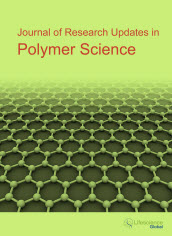jrups
Abstract : Effect of Side Chain Length on Segregation of Squalane between Smectic Layers Formed by Rod-Like Polysilanes
|
|
Abstract: The segregation of spherical molecules (squalane) between the smectic layers of rod-like polymers (polysilanes) with narrow molecular weight distributions were investigated by synchrotron radiation small-angle X-ray scattering (SR-SAXS), atomic force microscopy (AFM) observations, and molecular dynamics simulations to elucidate the effect of the polymer side chain length on the segregation. It has been theoretically predicted that the smectic phase of the rod-like particles will be stabilized by inserting the spherical particles into the interstitial region between the smectic layers when the diameter of the spherical particles is smaller than that of the rod-like particles whose length is sufficiently long. We found that the segregation of squalane was unaffected by the molecular weight (Mw) of the polysilane in the range of 9,200-44,100 g/mol, and the diameter of the polysilane showed the optimal size of 5.64 nm for the segregation of squalane whose diameter is 6.57 nm although the origin of these inconsistencies between theory and experiment is currently not clear. Keywords: Helical polymer, liquid crystal, smectic phase, depletion effect, rod and sphere. |
Abstract : Generation of Energy from a Single Fuel Cell Using Synthesized Solid Electrolyte Membrane from Functionalized Polyisoprene/ Carbon Nanotubes
|
|
Abstract: Study on the electrical energy generated from a single fuel cell using a synthesized solid electrolyte membrane from polyisoprene that was impregnated with carbonanotubes was carried out. The initial functionalization of the polymer yielded an ion exchange capacity (IEC) of 4.04, 7.82, 11.1 and 15.53 mmol/g with their corresponding degrees of sulphonation (DS) of 10.93, 21.1, 30.03 and 42.02 %, respectively. The later but highest DS achieved water uptake of 49.23 wt % and proton conductivities of 4.3 x 10-3, 1.2 x 10-3 and 2.6 x 10-2 S/cm for membrane of thickness 250, 215 and 120 mm, respectively. The performance testing of the membrane in a single fuel cell achieved an open circuit voltage (OCV) of 647.23 mV with the synthesised membrane of 35 wt % catalyst loading, 589.79 mV and 410.48 mV of 25 wt % and 15 wt % catalyst loading, respectively at constant DS (42.02 %). Their corresponding power densities achieved were 68.67, 49.20 and 35.83 Mw/cm2, respectively. Thus the functionalization of polyisoprene impregnated with carbon nanotubes through the process of sulphonation with chlorosulphonic acid resulted into the development of solid polymer electrolyte membrane for fuel cell application. Keywords: Energy, sulphonation, polyisoprene, carbonanotubes, fuel cell. |
Abstract : Comparative Study on Experimental and Kerner Model Predictions of Viscoelastic Properties of Polyamide 6/ Polyvinyl Alcohol Blends
|
|
Abstract: The Polyamide 6 (PA6) / Polyvinyl alcohol (PVOH) blends of different compositions (80/20, 60/40 and 50/50) were prepared by melt mixing in a Haake Rheomixer. The selected blend systems (80/20 and 60/40) were modified with dicumyl peroxide (DCP) and tertiary butyl cumyl peroxide (TBCP). The dynamic mechanical properties of blends were systematically investigated with special reference to the effect of blend ratio and effect of presence of peroxide over a temperature range -20°C to 110°C. The effect of change in the composition of the polymer blends on tan δ was studied to understand the damping characteristics. The mean field theory developed by Kerner has been used to estimate the dynamic properties and the estimated values are compared with the experimental values. The loss tangent curve of the blend exhibited single transition peak corresponding to the glass transition temperature (Tg) of Polyamide 6. Kerner model was found to satisfactorily predict the viscoelastic properties of the blends with polyamide content in the range 50 to 80 wt% assuming PA6 as matrix and for all compositions except 80/20 assuming PVOH as matrix. The Kerner model predictions for the selected blend systems with peroxides are not satisfactory and the co-continuous morphology of the peroxide treated blends were revealed by SEM observations. Keywords: Polymer blends, Dynamic mechanical analysis, Kerner model, Morphology, peroxide modified blends. |
Abstract : Photo Nitroxide-Mediated Living Radical Polymerization of Hindered Amine-Supported Methacrylate
|
|
Abstract: With the aim of obtaining giant polymer vesicles supporting a hindered amine that is converted into a redox catalyst on the vesicle shells, the living nature of the photo nitroxide-mediated living radical polymerization (photo NMP) of a monomer containing a hindered amine and the formation of the vesicles consisting of an amphiphilic diblock copolymer by the polymerization-induced self-assembly were investigated. The photo NMP of 2,2,6,6-tetramethyl-4-piperidyl methacrylate (TPMA) was performed in methanol using 4-methoxy-2,2,6,6-tetramethylpiperidine-1-oxyl (MTEMPO) as the mediator, 2,2’-azobis[2-(2-imidazolin-2-yl)propane] (V-61) as the initiator, and (4-tert-butylphenyl)diphenylsulfonium triflate as the accelerator by UV irradiation at room temperature. The first-order time-conversion plots had an induction period in which the MTEMPO molecules were captured by the initiator radicals and the monomer radicals generated by the initiation. It was confirmed that the polymerization proceeded by a living mechanism based on linear correlations of the molecular weight of the poly(TPMA) (PTPMA) versus the monomer conversion and the reciprocal of the initial concentration of V-61. Based on the livingness of the polymerization, the photo NMP-induced self-assembly for the block copolymerization of methyl methacrylate (MMA) using the PTPMA end-capped with MTEMPO was carried out in methanol to produce microsized giant spherical vesicles consisting of the amphiphilic PTPMA-block-poly(MMA) diblock copolymer. A differential scanning calorimetry study demonstrated that the vesicles had a single bilayer structure. Keywords: 2,2,6,6-Tetramethyl-4-piperidyl methacrylate (TPMA), Hindered amine, Photo nitroxide-mediated living radical polymerization (photo NMP), Photo NMP-induced self-assembly, Giant vesicles, Single bilayer structure. |






















